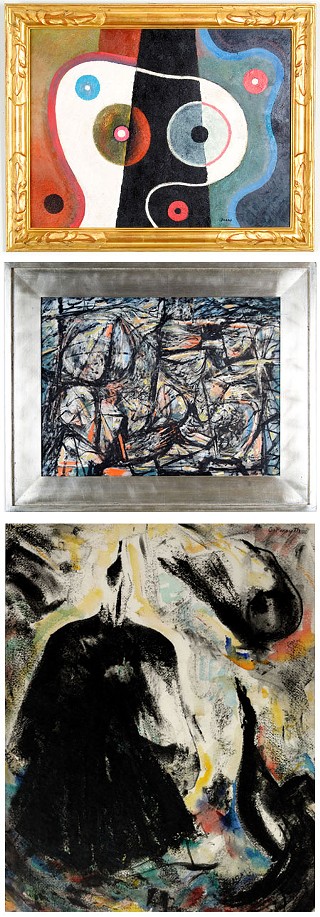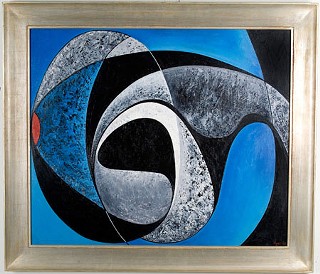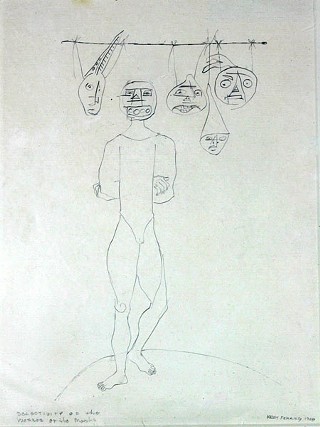Making the Scene
Looking back at the time when Austin was at the center of the Texas art world
By Amanda Douberley, Fri., Aug. 24, 2007
Images courtesy of Carl R. McQueary and Robert Summers
Anyone who's ever taken a 19th or 20th century art-history class has probably felt a little inundated by the parade of "-isms," movements, and schools that generally shape how we think about art. Attach a few artists' names and stylistic traits to these headings, and you're ready for the exam (or, perhaps, the museum), where images of paintings loom on a screen (or a white wall), devoid of context, ready for your appreciation.
But did anyone ever test your knowledge of a scene?
In contrast with a movement or a school, a scene describes a much looser association of individuals. A scene doesn't have a leader so much as people who are more or less influential than others. There are the insiders, the fringe dwellers, and the outsiders, a mix of people who fall in and out of the group, but there has to be, in general, something that ties these people together. In the case of art, it might be as simple as a specific place and a specific time.
"Austin Art Seen, Circa 1961," the exhibition currently showing at Austin Museum of Art-Laguna Gloria, describes a scene above all else. Despite its year-specific title, the show includes prints, drawings, paintings, and sculpture made by 17 artists from the 1940s through the 1960s, a time when Austin was at the center of the Texas art world. The work in the show might be loosely characterized as modern or abstract, but the artists featured here never signed a group manifesto, and no curator in their time (or since) ever canonized them as a school or movement. Instead, curator Carl R. McQueary uses selections from local collections to offer us a glimpse of a visual landscape, a slice of the creative foment that swept Austin during the mid-20th century.
The Foundation Laid

While a scene may be a loose descriptor, Austin's had a definite spark: the establishment, in 1938, of an art department at the University of Texas encompassing studio art, art history, and art education. Of course, there had been artists living in Austin before there was an art department. (Does the name Elisabet Ney ring a bell?) In fact, the Austin-based Texas Fine Arts Association had been lobbying for the creation of one for years. But the university attracted such a diverse and talented group of instructors, as well as students, that the course of art in Austin was irrevocably changed. This shift, however, did not happen all at once. During the nearly 25 years between its founding and 1961, the art department underwent transformations of its own, even as it fostered the larger Austin art scene.
Though neither artist is featured in "Austin Art Seen," the department's first chair, Ward Lockwood, and first instructor, Loren Mozley, undeniably set the tone for the years ahead. The pair came to Austin from New Mexico, where they had been living in Taos, home of a thriving artists' colony with strong ties to European art. During the 1920s, both artists studied in Paris, where they were exposed to all of the "-isms" taking shape at the time, including cubism, Dada, and surrealism. In Taos, each found a group of artists committed to personal development, questioning established norms, and finding their own way through these revolutions in art-making. Lockwood and Mozley brought these ideals with them to Austin and soon were joined by several prominent artists who helped mold the UT art department during its early years, among them the painters Everett Spruce and William Lester, the sculptor Charles Umlauf, and the printmaker Constance Forsyth. Although Lockwood would leave UT for good in 1947 to teach at the University of California-Berkeley, these other early faculty members taught at UT for as many as 40 years.
Spruce and Lester spent the early part of their careers in Dallas, the hub for so-called "regionalist" art in Texas during the Depression years. Of all the department's early faculty members, these two reveal in their work the impact of intense experimentation and critical inquiry both encouraged and made possible by the university environment. The harsh realities of the dust bowl, depicted in their earlier paintings with an earth-toned palette, gave way to brighter colors and a shift in each painter's style soon after they arrived at UT. Lester focused on breaking down his subjects into flat planes of color with architectonic compositions that express what he termed "structural reality." Spruce leaned more toward expressionism in paintings that channel the motion and life evident in nature. Neither artist completely abandoned his regionalist roots, instead combining earlier subject matter with cubist elements and more expressive brushwork. The result is another regionalism engaged with modernist rather than social realist art.
The Transformation

If the university had an impact on the art department's new faculty, these artists also brought Austin and UT to national attention through their participation in exhibitions around Texas and throughout the United States. Lockwood, Forsyth, Umlauf, and Spruce all exhibited in New York City within their first few years at UT, including at the National Academy of Design, the Whitney Museum of American Art, the Metropolitan Museum of Art, and the Museum of Modern Art. Chicago, Philadelphia, San Francisco, and other cities also saw the work of Austin's new arrivals. Within Texas, these artists participated in various gallery and museum shows, as well as in the annual juried "Texas General" exhibition, mounted cooperatively by the Dallas Museum of Fine Arts; the Museum of Fine Arts, Houston; and the Witte Memorial Museum in San Antonio. Especially in the case of artists recruited from outside of Texas, these exhibitions allowed Austin artists to add their new creative energy to the state's artistic culture. UT faculty also participated in local art shows as jurors, including the TFAA's annual juried exhibition, the "Texas Circuit." All of this energy not only drew attention but also more artists to the university. As Robert Summers and Chelsea Weathers note in their extensive paper on the UT art department's history, "The express purpose of the new college was to produce exceptional visual artists for the state, and the popularity and success of the faculty attracted students and more faculty to the University, and therefore to Texas."
The initial wave of artists arrived in Austin during the first five years that classes were offered at UT's art department; a second wave arrived soon after the end of World War II, when enrollment in art schools across the country skyrocketed. While the entire College of Fine Arts had only 109 students in 1938, enrollment in the art department alone jumped to 574 students by 1945. As the department ballooned, classes were moved from Battle Hall and the Main Building east to the site where the Geology and Winship Drama buildings now stand. Army barracks left over from the war housed classes and studios for 15 years. New faculty hired to help the department keep up with increasing demand included the painters Ralph White and Seymour Fogel in 1946, Fort Worth artist and art educator Kelly Fearing in 1947, ceramist and metalworker Paul Hatgil in 1951, painter Michael Frary in 1952, and printmaker and watercolorist John Guerin in 1953. Donald Weismann, a painter, art historian, and art educator, became the department's first nonstudio art chair in 1954.
If this list seems unnecessarily long, it is in the service of emphasizing the explosion of artistic energy that infused Austin within a relatively short amount of time. The diversity that characterizes the work of these artists may make a tidy, coherent survey impossible, but reveling in its variety is equally rewarding. For example, take White, Fearing, and Frary, another trio of artists who taught at UT for 30-plus years each. While White engaged in a sustained inquiry into painting techniques and extreme abstraction, Frary's work ranged from lyrical watercolors to eerie, invented landscapes in oil that are infused with surreal qualities. During the Fifties and Sixties, Fearing painted many figures in craggy landscapes, including saints and other biblical characters, as well as a variety of animals, especially owls. Fearing's magical realism, Frary's watercolors, and White's abstractions do not add up to a movement or school in the traditional sense, but taken together, their paintings tell us something about working in a specific place through a particular period of time. This is one of the pleasures of "Austin Art Seen."
McQueary has organized exhibitions of work by UT faculty members in the past – notably a pair of shows at the Umlauf Sculpture Garden & Museum in 2004 and 2005, both titled "Modernist" – and with "Austin Art Seen" he apparently aims to engage artists outside of the university's mid-20th century pantheon of professors. For example, he has included work by William Hoey, Louise LaBauve, and Don Snell, all of whom studied at UT, and in Hoey's case, taught there as well. Amy Freeman Lee spent most of her life in San Antonio but was involved with the university and exhibited around the state, in addition to being a close friend of several faculty members, including Fearing. Still, with more than half of the artists in the exhibition drawn from UT's faculty and the rest having had some sort of tie to UT, McQueary puts the university squarely at the center of the "scene" portrayed here.
The Next Generation
In many ways, the early 1960s were a time of transition for the Austin art scene: "Austin Art Seen" marks the end of one era and the beginning of another. In 1961, Laguna Gloria Art Museum was established as a separate chapter of TFAA, with the museum assuming responsibility for organizing exhibitions at the Driscoll Villa, which had been deeded to TFAA in 1942. (Laguna Gloria has since morphed into the Austin Museum of Art, while TFAA has changed its name to Arthouse, both with headquarters on Congress Ave-nue in Downtown Austin.) Mean-while, at the university, the de-partment added master's degrees in studio art, art education, and art history to its curriculum in 1960. At the time of its 25th anniversary, the department moved into the new art building at the corner of 23rd and San Jacinto streets. Exhibitions that had been mounted in various locations on campus since the department's inception finally had a permanent home inside this building at the University Art Museum (which was renamed the Archer M. Huntington Gallery in 1980 and became the Jack S. Blanton Museum of Art in 1997).
Besides these institutional changes, artists' work was changing, too. In 1971, Mozley described the current Austin art scene by giving voice to the shifts that had already taken place: "Austin has been the home of several first-rate painters and sculptors in recent years and has produced a succession of younger talents, but there has never been an 'Austin School' or any group of artists living here who shared a common style or aesthetic. The character of the local expression now seems to be changing, however, and although the exhibition catalogues may continue to list the familiar names of those who paint pictures and make sculpture, the community includes a number of young craftsmen and artists who work in media and concepts far outside our former notions of the limits of painting and sculpture." Clearly, the new artistic revolutions of the 1960s had taken hold in Austin. Abstraction – once a signifier of avant-garde art and the dominant trend in Austin art-making throughout the 1940s and 1950s – had become the norm, only to be replaced by another series of artistic challenges.
Mozley retired from teaching a few years after making these observations. Between 1972 and 1975, all of the first-generation UT faculty (except Umlauf) had retired, each one as professor emeritus. Umlauf followed in 1981, becoming the leading edge of second-generation retirees. Fearing, the last early faculty member to leave the classroom, retired professor emeritus in 1987. One year later, the art department celebrated its 50th anniversary. The days of leaky army barracks and nomadic art exhibitions weren't even a distant memory for most of, if not all of, those teaching at the university. The scene had changed, as it inevitably does.
"Austin Art Seen, Circa 1961" continues through Sept. 27 at Austin Museum of Art-Laguna Gloria, 3809 W. 35th. For more info, call 458-8191 or visit www.amoa.org.













